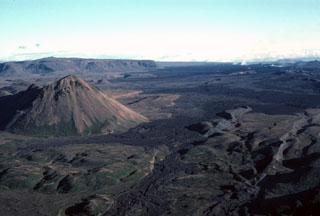Report on Krafla (Iceland) — December 1985
Scientific Event Alert Network Bulletin, vol. 10, no. 12 (December 1985)
Managing Editor: Lindsay McClelland.
Krafla (Iceland) No net inflation in 1985; small deflation episode in July
Please cite this report as:
Global Volcanism Program, 1985. Report on Krafla (Iceland) (McClelland, L., ed.). Scientific Event Alert Network Bulletin, 10:12. Smithsonian Institution. https://doi.org/10.5479/si.GVP.SEAN198512-373080
Krafla
Iceland
65.715°N, 16.728°W; summit elev. 800 m
All times are local (unless otherwise noted)
The following is from the NVI.
"The inflation of Krafla after the September 1984 eruption (9:8, 10-11) apparently came to a halt during January 1985. Recording tiltmeters at Krafla and Víti showed no significant inflation from January through late May although the conventional winter noise would have prevented detection of a miniscule inflation. After the winter noise subsided in April 1985, a very slight tilt, indicating deflation, prevailed in the Krafla power station, where the tilt rate was ~6 µrad/month.
"On 21 May, however, significant inflation started at Krafla with a tilt rate of ~10 µrad/month. This corresponds to an inflation rate of about 1 mm per day at Leirhnjúkur. This inflation continued until 1 July. A noticeable subsidence was recorded 1-3 July on the Krafla and Víti tiltmeters. The tilt at Krafla in the conventional subsidence direction was about 14-17 µrad, corresponding to land subsidence of about 5 cm at Leirhnjúkur. The Víti tiltmeter showed about 12 µrad of tilt toward the WSW, the usual subsidence tilt direction. This corresponds to a removal of 2 x 106 m3 of magma from the Krafla magma reservoir.
"After 3 July no noticeable inflation or deflation was observed at Krafla or Víti, although minimal inflation may have occurred during November. An apparent deflation at Krafla in July and early August was probably caused by thermal stress, but similar tilt was observed in July and August 1983 and 1984. This signifies an annual cycle in tilt at this station. Dry-tilt measurements during the last days of May and again in late October indicate subsidence centered near Leirhnjúkur between those dates. The maximum subsidence was about 4.5 cm, similar to that indicated by the Krafla tiltmeter on 1-3 July.
"Although obvious ground deformation occurred 21 May-3 July, the net ground movement throughout the year was near zero and only further measurements in 1986 will show if any measurable deformation is in progress. Measurements of ground deformation at Krafla in 1985 do not allow any conclusion regarding the present progress or expected continuation of the activity. The inflation, if any, is slower than during any previous one-year period after 1975. The small subsidence event of 1-3 July is different from all earlier events, as no inflation was observed after the subsidence. Thus the behavior of Krafla is greatly different from what it has been during the previous 9 years and the experience from those years is of no use in predicting the continuation of activity at Krafla."
Geological Summary. The Krafla volcanic system in the Northern Volcanic Zone (NVZ) of Iceland is about 100 km long, consisting of a fissure swarm and a central volcano with a 7 x 9 km caldera formed about 110,000 years ago that deposited a rhyolitic welded tuff. It has been moderately active in the Holocene, over three distinct eruptive periods; the current one has lasted about 2,800 years with six volcano-tectonic episodes, each with one or more basaltic fissure eruptions. Lava volumes (DRE) have been in the 0.1-1 km3 range. The Hverfjall and Ludent tuff rings east of Myvatn were erupted along the fissure system. Myvatn lake formed during the eruption of the older Laxarhraun lava flow from the Ketildyngja shield volcano of the Fremrinamur volcanic system about 3,800 years before present (BP); The present Myvatn lake is constrained by the roughly 2,000 years BP younger Laxarhraun lava flow from the Krafla volcanic system. The abundant pseudocraters that form a prominent part of the Myvatn landscape were created when the younger Laxarhraun lava flow entered the lake. The last eruption took place in 1975-1984 CE when nine small basaltic fissure eruptions produced 0.25 km3 of lava.
Information Contacts: E. Tryggvason, Univ. of Iceland.

